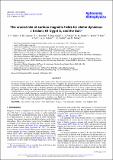The crucial role of surface magnetic fields for stellar dynamos : ϵ Eridani, 61 Cygni A, and the Sun
Abstract
Cool main-sequence stars, such as the Sun, have magnetic fields which are generated by an internal dynamo mechanism. In the Sun, the dynamo mechanism produces a balance between the amounts of magnetic flux generated and lost over the Sun's 11-year activity cycle and it is visible in the Sun's different atmospheric layers using multi-wavelength observations. We used the same observational diagnostics, spanning several decades, to probe the emergence of magnetic flux on the two close by, active- and low-mass K dwarfs: 61 Cygni A and ϵ Eridani. Our results show that 61 Cygni A follows the Solar dynamo with a regular cycle at all wavelengths, while ϵ Eridani represents a more extreme level of the Solar dynamo, while also showing strong Solar-like characteristics. For the first time we show magnetic butterfly diagrams for stars other than the Sun. For the two K stars and the Sun, the rate at which the toroidal field is generated from surface poloidal field is similar to the rate at which toroidal flux is lost through flux emergence. This suggests that the surface field plays a crucial role in the dynamos of all three stars. Finally, for ϵ Eridani, we show that the two chromospheric cycle periods, of ~3 and ~13 years, correspond to two superimposed magnetic cycles.
Citation
Jeffers , S V , Cameron , R H , Marsden , S C , Boro Saikia , S , Folsom , C P , Jardine , M M , Morin , J , Petit , P , See , V , Vidotto , A A , Wolter , U & Mittag , M 2022 , ' The crucial role of surface magnetic fields for stellar dynamos : ϵ Eridani, 61 Cygni A, and the Sun ' , Astronomy and Astrophysics , vol. 661 , A152 . https://doi.org/10.1051/0004-6361/202142202
Publication
Astronomy and Astrophysics
Status
Peer reviewed
ISSN
0004-6361Type
Journal article
Description
Funding: SVJ acknowledges the support of the DFG priority programme SPP 1992 “Exploring the Diversity of Extrasolar Planets (JE 701/5-1)”. RHC’s contribution to this work was supported in part by ERC Synergy Grant WHOLE SUN 810218. RHC benefited from discussions at the ISSI team ‘What determines the dynamo effectively of solar active regions?’. SBS acknowledges funding from the Austrian Science Fund (FWF) under the Lise Meitner grant M 2829-N. MMJ acknowledges support from STFC Consolidated Grant ST/R000824/1. VS acknowledges funding from the European Research Council (ERC) under the European Unions Horizon 2020 research and innovation programme (grant agreement No. 682393 AWESoMeStars). AAV acknowledges funding from the European Research Council (ERC) under the European Union’s Horizon 2020 research and innovation programme (grant agreement No. 817540, ASTROFLOW). Based on observations obtained at the Telescope Bernard Lyot (USR5026) operated by the Observatoire Midi-Pyrénées, Université de Toulouse (Paul Sabatier), Centre National de la Recherche Scientifique of France. Wilcox Solar Observatory (WSO) data used in this study were obtained via the web site http://wso.stanford.edu, courtesy of J. T. Hoeksema. This work uses data obtained with the TIGRE telescope, located at La Luz observatory, Mexico. TIGRE is a collaboration of the Hamburger Sternwarte, the Universities of Hamburg, Guanajuato and Liège. The Mount Wilson Observatory HK Project was supported by both public and private funds through the Carnegie Observatories, the Mount Wilson Institute, and the Harvard-Smithsonian Center for Astrophysics starting in 1966 and continuing for over 36 years. These data are the result of the dedicated work of O. Wilson, A. Vaughan, G. Preston, D. Duncan, S. Baliunas, and many others. The research leading to these results has received funding from the European Community’s Seventh Framework Programme (FP7/2013-2016) under grant agreement No. 312430 (OPTICON).Collections
Items in the St Andrews Research Repository are protected by copyright, with all rights reserved, unless otherwise indicated.

